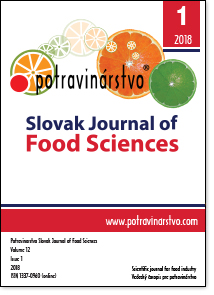Heating and dehydration of grain and cereals at a combined energy supply
DOI:
https://doi.org/10.5219/840Keywords:
IR, radiation, grain, dehydration, heatAbstract
The paper dwells on the development of experimental dependencies of heating and dehydration of grain and cereals when varying the irradiance, ambient temperature in the heat treatment zone and the initial moisture content of product, and the development of the mathematical models for heating and dehydration of some grains and cereals. The grain was heated on the laboratory equipment with quartz halogen linear infrared emitters. The irradiance on the working surface in the treatment zone was determined by calculation using a specially developed program. The ambient temperature was determined by a thermocouple thermometer placed in a ceramic tube. The grain temperature was estimated as average by weight by a thermocouple thermometer after its transfer into a thermally insulated container. The following dependencies have been obtained: 1 - Temperature dependence of the heating time for different heating modes and initial moisture content. 2 - Dependence of moisture content on the heating time under different conditions and initial moisture content. 3 - Dependence of moisture content on a temperature under different conditions and constant initial humidity. The models of the heat-moisture exchange and dehydration processes have been created, and the model parameters K0 and KT of the temperature dependence of some grains have been identified, as well as their dependence on moisture content and treatment modes has been evaluated. It has been established that this model describes adequately the process of dehydration to an extent limited by the upper temperature value of grain not much more than 100 ºÐ¡. Within not limited to the upper temperature value of grain not much more than 100 ºÐ¡. From the presented graphs and earlier obtained results for barley and millet, it can be assumed that the model describes adequately experimental data on the small-sized (3 - 5 mm) objects.
Downloads
Metrics
References
Kulaychev, A. 1999. The complete works in three volumes Vol. 1. In Kulaychev, A. et al. Methods and tools of data analysis in a Windows environment STADIA-6. Information and computers, 344 p. ISBN 5-89-357-016-2.
Lykov, A. V., Mikhailov, Y. A. 1963. Theory of heat and mass-transfer. University of Michigan, USA : Israel Program for Scientific Translations publishers, 558 p.
Pan, Z., Atungalu, G. G. 2010. Infrared Heating for Food and Agricultural processing. Boca Raton, Florida, US : CRC Press. 300 p. ISBN-13: 9781420090970.
Zverev, S. V. 2009. High-temperature micronization in production of cereal products. Deli Print publishers. 222 p. ISBN 978-5-94343-202-6.
Downloads
Published
How to Cite
Issue
Section
License
This license permits non-commercial re-use, distribution, and reproduction in any medium, provided the original work is properly cited, and is not altered, transformed, or built upon in any way.






























